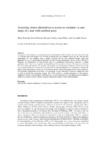Mostrar o rexistro simple do ítem
Assessing mouse alternatives to access to computer: a case study of a user with cerebral palsy
| dc.contributor.author | Pousada, Thais | |
| dc.contributor.author | Pereira-Loureiro, Javier | |
| dc.contributor.author | Groba, Betania | |
| dc.contributor.author | Nieto-Riveiro, Laura | |
| dc.contributor.author | Pazos, A. | |
| dc.date.accessioned | 2016-11-18T12:20:51Z | |
| dc.date.available | 2016-11-18T12:20:51Z | |
| dc.date.issued | 2014 | |
| dc.identifier.citation | Pousada T, Pereira J, Groba B, Nieto L, Pazos A. Assessing mouse alternatives to access to computer: a case study of a user with cerebral palsy. Assist Technol. 2014;26(1):33-44 | es_ES |
| dc.identifier.issn | 1040-0435 | |
| dc.identifier.issn | 1949-3614 | |
| dc.identifier.uri | http://hdl.handle.net/2183/17572 | |
| dc.description.abstract | [Abstract] The purpose of this study is to describe the process of assessment of three assistive devices to meet the needs of a woman with cerebral palsy (CP) in order to provide her with computer access and use. The user has quadriplegic CP, with anarthria, using a syllabic keyboard. Devices were evaluated through a three-step approach: (a) use of a questionnaire to preselect potential assistive technologies, (b) use of an eTAO tool to determine the effectiveness of each devised, and (c) a conducting semi-structured interview to obtain qualitative data. Touch screen, joystick, and trackball were the preselected devices. The best device that met the user's needs and priorities was joystick. The finding was corroborated by both the eTAO tool and the semi-structured interview. Computers are a basic form of social participation. It is important to consider the special needs and priorities of users and to try different devices when undertaking a device-selection process. Environmental and personal factors have to be considered, as well. This leads to a need to evaluate new tools in order to provide the appropriate support. The eTAO could be a suitable instrument for this purpose. Additional research is also needed to understand how to better match devices with different user populations and how to comprehensively evaluate emerging technologies relative to users with disabilities. | es_ES |
| dc.language.iso | eng | es_ES |
| dc.publisher | Taylor & Francis para RESNA | es_ES |
| dc.relation.uri | http://dx.doi.org/10.1080/10400435.2013.792880 | es_ES |
| dc.rights | This is an accepted manuscript of an articled published by Taylor & Francis in "Assistive Technology", avaliable at Taylor & Francis Online | es_ES |
| dc.subject | Accesibility | es_ES |
| dc.subject | Assistive technology | es_ES |
| dc.subject | Computer access | es_ES |
| dc.subject | Disability | es_ES |
| dc.subject | Evaluation | es_ES |
| dc.title | Assessing mouse alternatives to access to computer: a case study of a user with cerebral palsy | es_ES |
| dc.type | info:eu-repo/semantics/article | es_ES |
| dc.rights.access | info:eu-repo/semantics/openAccess | es_ES |
| UDC.journalTitle | Assistive Technology | es_ES |
| UDC.volume | 26 | es_ES |
| UDC.issue | 1 | es_ES |
| UDC.startPage | 33 | es_ES |
| UDC.endPage | 44 | es_ES |
Ficheiros no ítem
Este ítem aparece na(s) seguinte(s) colección(s)
-
GI-RNASA - Artigos [193]
-
INIBIC-RNASA-IMEDIR - Artigos [46]






